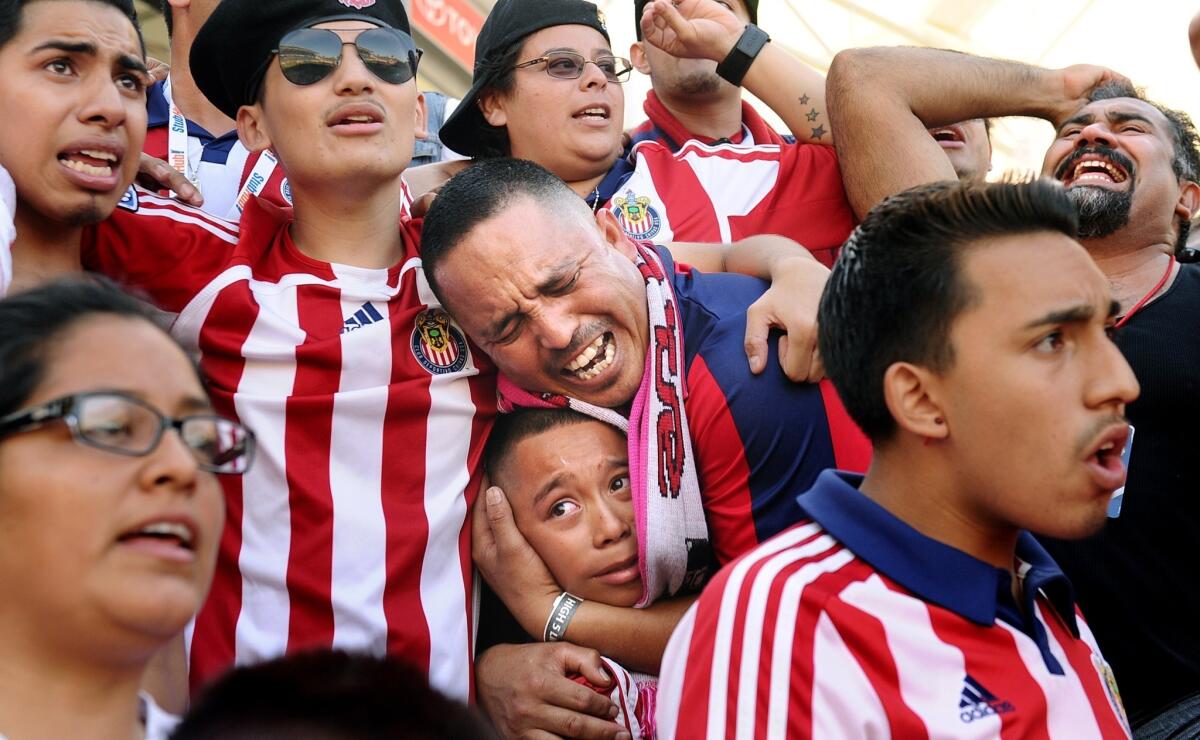Chivas USA’s long road to demise was paved with bad decisions

- Share via
Don Garber was almost giddy on the day, 11 years ago this month, that he announced Major League Soccer was partnering with the most iconic franchise in Mexican sports to form an MLS expansion team.
“I was very excited when we launched Chivas USA [with] the vision that they had to expand, to extend the Guadalajara brand and to really be a team for Southern California Hispanics,” the MLS commissioner recalled.
Garber shared that memory three days after the league folded the team, finally accepting what everyone else had known for years: The Chivas USA experiment was a failure.
Or, as Garber likes to call it, a learning experience.
“That strategy wasn’t effective,” he says now. “The strategy was not one that was succeeding. And not one that the league believed would be able to succeed going forward.”
So what went wrong?
Plenty. And the foundation for that failure may have been laid before the team played its first game.
Among the problems:
•The team never had its own stadium, and the league’s decision to have it share one with the more-established Galaxy made Chivas USA a visitor in its own home.
•The team’s relationship with Mexican club Chivas of Guadalajara, with which it shared a name, an owner and a uniform, was supposed to be its strength. But it proved a much bigger liability. In Mexico, Chivas is loved and hated with equal passion, so supporters of other Mexican clubs never gave the MLS team a second glance. For others, Chivas USA’s tight focus on the Latino community at the expense of the broader Southern California market was even more alienating.
•Management’s idea to stock its roster with Mexicans — another original selling point since Chivas of Guadalajara hasn’t used a non-Mexican player in its 108-history — was unworkable in MLS, where rules limit both salaries and the number of foreign-born players per team.
•The team waffled on an identity, going from a team led by Mexicans to a roster of U.S. and South American players and back again, sometimes within the same season.
“There were challenges with the idea of Chivas USA from the very beginning,” says Keegan Pierce, the team’s communications director the first five seasons. “They identified early on that there was a group of soccer fans in Southern California who might not be following Major League Soccer or the Galaxy and who were huge fans of Mexican soccer.
“The Chivas association created too many expectations that a team based in Major League Soccer simply wasn’t able to fulfill…. The idea needed to be radically different.”
After a debut season in which it had as many head coaches, four, as victories, Chivas USA made the playoffs in each of the next four seasons, though it used two U.S. coaches — Bob Bradley, then Preki — and a roster stocked with U.S. national team players such as Jonathan Bornstein, Sacha Kljestan and Ante Razov.
“At the beginning, we brought the Mexican team. That was the whole idea,” says Antonio Cue, a co-owner and the team’s president. “[But] it didn’t work because we brought a Team B of Mexico. So the second year we changed a little bit and tried to be more competitive.”
By 2011, the team had just one Mexican player left, and management was feuding over the franchise’s personality. Cue and his brother Lorenzo, also a co-owner, led an L.A.-based faction that favored doubling down on the more inclusive model that had produced four playoff teams. But Chivas of Guadalajara owner Jorge Vergara, who lived in Mexico, wanted to make the team something of an extension of his franchise in Jalisco.
“They didn’t understand anymore what their identity had to be,” said Ricardo Lopez, sports editor of the Spanish-language newspaper La Opinion. “The owner of the team didn’t know who they were. Things can’t go well under that situation.”
As the tug-of-war between the owners continued, attendance fell by more than half, bottoming out at an MLS-record low average of 7,062 a game this season. The team lost its shirt sponsor, struggled to get on local TV, had to buy time on Spanish-language radio to get its games broadcast, and over its final four seasons lost millions of dollars while winning just 30 games.
At one point, the league successfully brokered a truce between Cue and Vergara, but it was one that — to the surprise of MLS — ended with Vergara buying out his partner in the summer of 2012. That only quickened the death spiral.
Shortly after the sale, Vergara presided over a staff meeting at a Westside boutique hotel where he restated that Spanish would be the official language of his club. Within months, the team’s payroll was more than $500,000 lower than any other MLS club, Chivas’ roster was stocked with five players on loan from Guadalajara, two former Mexican league coaches were brought in to run the team, and three U.S. employees had filed discrimination lawsuits.
So the league’s embarrassed owners stepped in again last February and bought Vergara out for a reported $70 million — or $60 million more than it had cost Chivas to join the league in 2004. Last week, MLS officially pulled the plug on the team, selling the rights for a second Southern California franchise to a glitzy, deep-pocketed ownership group whose first task will be to erase the memory of Chivas USA before the new team begins play in 2017.
By the end, even the players knew it was time to move on, says Carlos Bocanegra, the team’s captain before a concussion ended his season in July.
“Everybody thought this was a great decision,” he said of the mood in the locker room. “And it needed to happen. It just really happened a few years too late.”
Twitter: @kbaxter11








